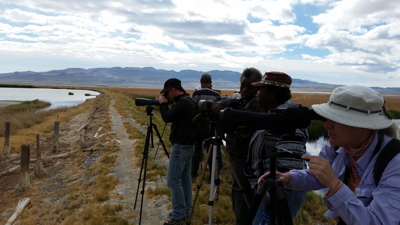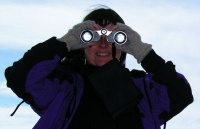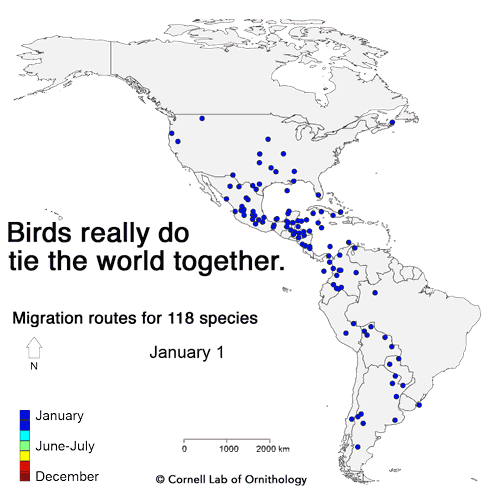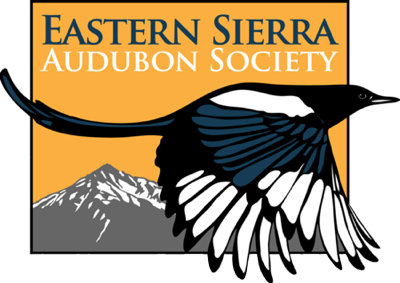
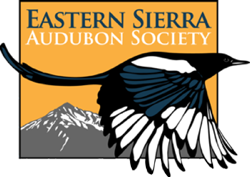
Sierra Wave
Newsletter
Volume 34, Number 3
January-February, 2016
Sierra Wave Newsletter
Volume 31, Number 4
March-April, 2013
Contents
- Events:
- Features:
- Reports:
- CBC- Report on the 2015 Bishop Christmas Bird Count
- Owens Lake Update, Pete Pumphrey and Michael Prather
- Owens Lake Events to look forward to:
- Business
Events
March 3rd: Osprey Research in the Mono Basin with Lisa Fields
Thursday, March 3, 2016, U.S. Forest Service/BLM Building in Bishop, 7:00pm
Our next program will be held on March 3rd at the U.S. Forest Service/BLM Building in Bishop on West Line Street, near the DMV. Please welcome our guest speaker, Lisa Fields, who will be giving a presentation on her Osprey Research. Doors open at 6:30, with the presentation starting at 7:00pm.
Osprey Natural History and Research in the Mono Basin
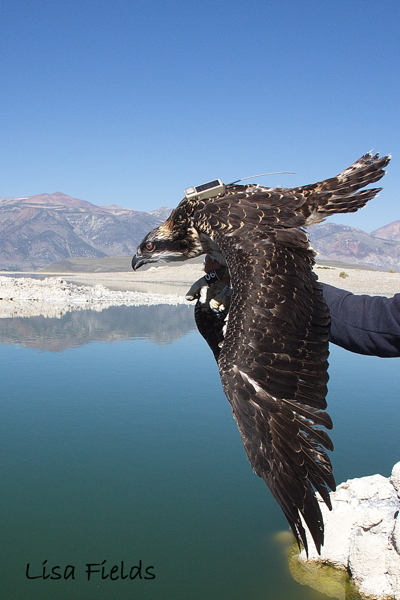
Meet Nigel - ready to transmit data, photo by Lisa Fields
Osprey Researcher Lisa Fields will speak about Osprey natural history including their range, identification, their behavior, and some of the past issues they have faced as a species. Then she will focus on the research that she's been conducting at Mono Lake since 2004. This includes nesting success as well as investigating local and long distance movements through nestling banding and satellite telemetry. Many aspects of this work have been supported by financial support from the Eastern Sierra Audubon Society.
Lisa Fields is an ecologist for the Southern Service Center of California State Parks. She is based in San Diego but works in parks extending from the Mexican border to central California. Her passion is raptor management, particularly the Osprey at Mono Lake. She initiated the nest monitoring program that began in 2004 and the nestling banding program that was started in 2009, and the use of GPS transmitters in 2013 to track migration.
Questions/comments: programs@esaudubon.org; 760-920-8541.
Back to Top
Upcoming ESAS Field Trips and Other Events
Sierra Bighorn Field Trip, January 30, 2016
The California Department of Fish & Wildlife and the Sierra Nevada Bighorn Sheep Foundation will hold their first field trip of 2016 to observe Sierra bighorn in their winter habitat. This trip will take place on Saturday, January 30th. We will meet at 9 a.m. at the CDFW office parking lot in Cottonwood Plaza, 787 N. Main St. Suite 220. Please wear sturdy boots and bring sunscreen, snacks, water, and binoculars if you have your own.
Space is limited! Please email asksnbs@wildlife.ca.gov or call (760) 873-3260 for reservations, directions, or more details!
Back to Top
 Winter Wildlife Field Trip with Tom & Jo Heindel
Winter Wildlife Field Trip with Tom & Jo Heindel
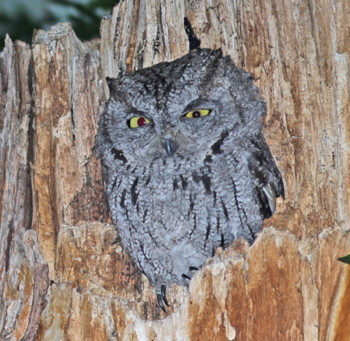
Hypnotic Owl says you WILL come on this trip!
(Western Screech Owl spotted on a previous Winter Wildlife Tour)
Photo by Tom Heindel
February 20, 2016, 8:00 am
On 20 February 2016, Tom & Jo Heindel have planned their annual Winter Wildlife Field Trip from Klondike Lake to Tinemaha Reservoir. The start time is 8:00 am at Glacier View Campground at the intersection of Hwy 395 & 168 in north Big Pine.
The route includes Klondike Lake, Warren Lake, the Big Pine canal road, Fish Springs fish hatchery, and ends at the upper overlook on Tinemaha Reservoir about noon. Bring your own water, snacks, binoculars, and telescope if you have one.
For more information call Tom & Jo Heindel at 760-938-2764.
Back to Top
 Monthly Bishop Paiute Tribe COSA, Bird Walk and Census Dates:
Monthly Bishop Paiute Tribe COSA, Bird Walk and Census Dates:
2016 COSA Walk Dates:
- January 9, 8:30 am
- February 13, 8:30 am
- March 12, 8:30 am
- April 9, 8:30 am
- May 14, 8:30 am
- Meet at 7:30 these months:
- June 11, 7:30 am
- July 9, 7:30 am
- August 13, 7:30 am
- September 10, 7:30 am
- October 8, 8:30 am
- November 12, 8:30 am
- December - will coordinate with the Bishop CBC for date and time!
[COSA walks are held on the second Saturday of every month, unless otherwise announced]
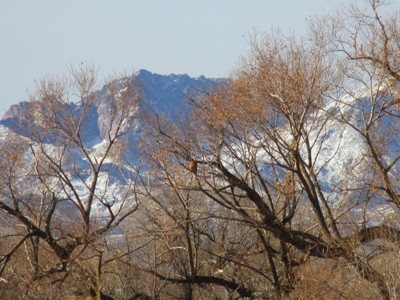
Winter birding in the COSA
Unless otherwise indicated, our COSA bird walks will all be the second Saturday of the month, except (sometimes) for December, because we will have it coincide with the Christmas Bird Count. During June, July, August, and September they will start at 7:30 instead of 8:30. Watch the monthly email update, this field trips page, or local media for confirmation, updates on leader(s) and meeting time. Or, contact Hillary (below), or if you just show up at 8 or so, you'll probably find us!
The Conservation Open Space Area is being developed for wildlife and the community by the Bishop Paiute Tribe. We'll be keeping species lists and observing behavior as well as identifying birds, for the purpose of creating bird lists for the site. For more information, read this article on the COSA in the March-April 2013 Sierra Wave newsletter. There have been surprises every month so far - come find out what new birds we'll see next time - maybe you'll add toour bird list on e-Bird!
All are welcome - these walks are for birders of ALL LEVELS, beginners included! We will bring extra binoculars and field guides to share. If you'd like to print out a bird checklist, with blanks for adding your own discoveries, you can download that here: COSA Bird Checklist trifold (pdf)
Please meet at 7:30am in June-September, or 8:30am during October-May at the BLM/Forest Service Building on West Line Street in Bishop. Contact Hillary Behr for more information, or if you are interested in leading a future monthly walk: hillarybehr@yahoo.com.
Back to Top
Back to Top
Features
Casual Bird Species in the Eastern Sierra: Fall 2015
[Birds in bold type have a photo in the article (or linked) - click on any photo to see all in a slideshow]
The official ornithological Fall Season ended 30 November for administrative purposes. Birds don't give a hoot, pardon the pun, about the administration of their comings and goings but journals do. So for bird data purposes, Fall includes all of August through November even though birds migrate from mid June through December and into early January with a few gracing many Christmas Bird Counts across the nation. Late migrants trickle out as insect prey continues to diminish under our harsh winter conditions.
Inyo County had an amazing Fall, if one measures it by the number of casual species recorded. A casual species has been recorded very few times and averages six or fewer years per decade. They are not normally present during an "appropriate" season but over time a pattern has appeared. These are species that when a birder finds one he/she first grabs their camera to take images and then grabs their phone to call others who help get the word out. There were gobs of pixels and user minutes used up this fall!
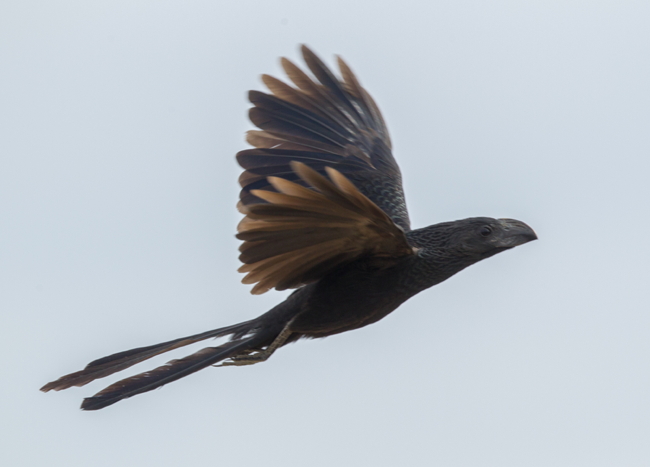
First ever record for Inyo County: Groove-billed Ani
Photo by Steve Brad
Undoubtedly the most exciting find, and first record ever for Inyo County, occurred 27 October when Steve Brad found a Groove-billed Ani at the Coso Rest Area. This species is resident throughout most of Mexico, Central America, and northern South America and just barely gets into southern Texas. There are 11 previous records in California with the last one reported in 1998. Most records fall between mid September and late December with one record mid April to early June and another record early December to early May. This will be the 12th state record after it is reviewed and accepted by the California Bird Records Committee, the northernmost ani in the state, and it falls in the middle of the state's Fall season window. Steve is to be commended for following the proper protocol-photographing first and getting the word out. People from all over the state for the next few days tried to get to Coso to see the bird and many were successful if they didn't arrive after 28 October.
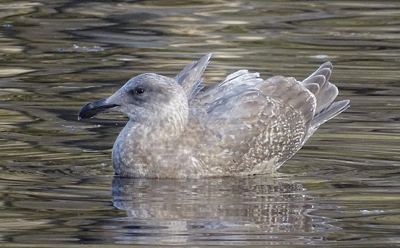
Bishop City Park attracts "tourists" from all over!
The number of casual species reported this fall was amazing. Besides the ani, there were 13 more casual species with the vast majority photographed and the few others well described. Remember that casual birds are more unexpected than rare species. Two other casuals are CRBC Review Species with a Rusty Blackbird, ~50 Inyo County records, photographed by Brent Campos at Furnace Creek Ranch 5 November and the continuing Curve-billed Thrasher residing at Starlite with photographs taken each month by Rick & Karen Scott. Both the third Inyo County record of Tropical Kingbird, photographed at Stovepipe Wells 6 September, and the fifth Inyo County record of Glaucous-winged Gull, photographed at Bishop City Park 23 November, were found by Chris & Rosie Howard. This first winter gull was seen and photographed through 4 December.
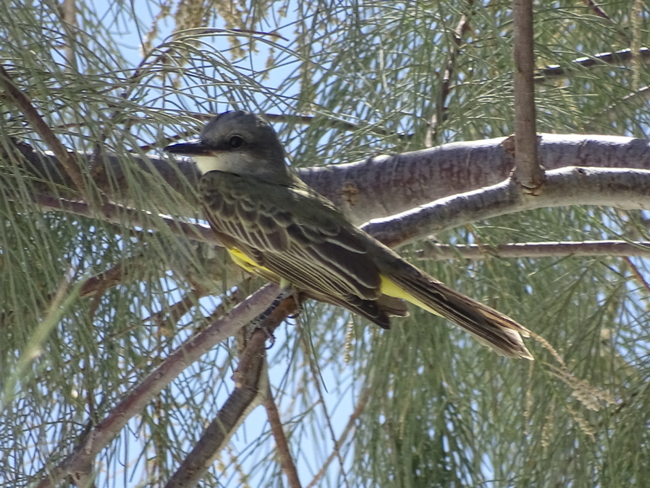
Gorgeous Tropical Kingbird visits Death Valley - 3rd Inyo County Record
Photo by Chris Howard
And the list continues:
- Mountain Plover photographed at Furnace Creek Ranch 26 August (SHS)
- Red Phalarope photographed at Owens Lake 20 August (C&RH)
- Common Ground-Dove with one bird photographed at Deep Springs College (restricted access) 10–11 October (SLS, et al.) and 1–2 birds (1 photographed, KH-L) at the Independence woodlot 26 October–7 December (JTZ, UL)
-
Eastern Phoebe
photographed in Shoshone 29 October (JCS) (photo below)
- Purple Martin a well-described male at Tinemaha Reservoir 3 September (CAM)
- Chestnut-sided Warbler photographed at China Ranch 15 September (LSW)
- Painted Bunting adult male in Shoshone 25 October (PAD) continued through 29 October when photographed (JCS)
- Baltimore Oriole 1 well-described immature at China Ranch 12 September (AEK) and
- Purple Finch with 1 well-described female plumaged bird at Furnace Creek Inn 18 September (JEP), another well-described female-type at Furnace Creek Ranch 5 November (BRC), and up to five birds, all immature/female types with two photographed, in Bishop 26–29 November (DVP, LBH) (photo below)
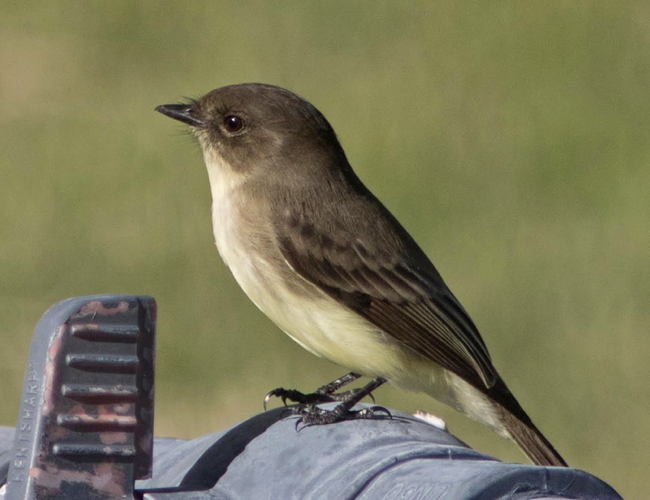
Eastern Phoebe photographed in Shoshone 29 October
Photo by John Sterling
Inyo County is the beneficiary of a cadre of birders who are also bird data gatherers. The difference is multifold but basically data gatherers take a professional path and strive mightily to prove their avian claims. Photographs are the preferred type of evidence, by both the birders and the county coordinators, but some birds do not cooperate so bird data gatherers get out their notebooks and begin writing descriptions…in the field or very shortly after seeing the bird and before looking in a field guide. They describe the bird — its looks, vocalizations, behavior, etc. — and add depth to the bird by describing the habitat and a descriptive story of the event. What they leave behind is not a stadium full of raised hands claiming this, that, or the other, but reliable data that will be carefully stored and excitedly searched by those not yet born that explains what was where, when, and in what numbers. To them we offer our gratitude and the gratitude of the future who will be thrilled with access to an amazing collection of reliable data.
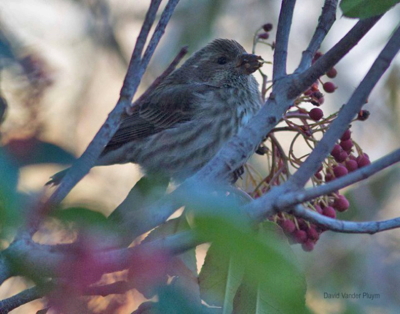
Purple Finch photographed in Bishop by David Vander Pluym
We tip our hats to the bird data gatherers in this article, alphabetized by first initial: Brent Campos, Chris & Rosie Howard, Curtis Marantz, David Vander Pluym, Jerry Zatorski, Jim Pike, John Sterling, Kelli Heindel-Levinson, Lauren Harter, Len Warren, Patrick Donnelly, Rick & Karen Scott, Sandy Koonce, Stephanie Stewart, Steve Brad, Susan Steele, and Ulla Lipp, plus 14 others whose names did not appear in this article but whose dozens and dozens of records will be added to the Inyo County Avian database.
Happy New Year to all and to all a good night!
By Tom & Jo Heindel
Return to Top
Bird of the Month
Board Member Santiago Escruceria will be sharing a photo of a different bird each month - and all can be seen at the Bishop Paiute Tribe's COSA - join us there on the second Saturday of each month to see these birds and more! See upcoming field trips here.
Black-headed Grosbeak - coming this spring to a feeder near you!
The Black-headed Grosbeak is a fairly large bird with a very fat but stubby beak with a dark gray upper bill and paler gray lower bill. It has a black back and hood, and a mostly orange body. The tail and wings are black with two white wing bars. They are very vocal in the spring, with a song that resembles that of an American Robin but with more rapid and higher notes. Seen at the COSA Eastern Sierra reserve, uncommon in riparian areas and aspen groves.
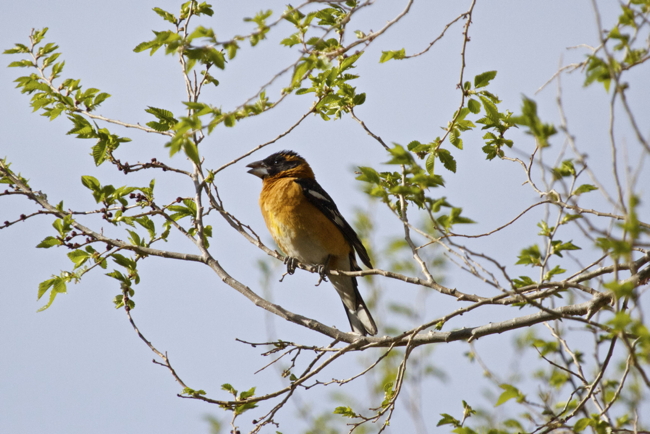
Black-headed Grosbeak - photo by Santiago Escruceria
Sources:
- The Sibley Guide To Birds. Second Edition, 2014. Written and illustrated by David Allen Sibley.
- The Stokes Field Guide To The Birds Of North America. First Edition, 2010. Donald and Lillian Stokes.
- Birds Of The Sierra Nevada, Their Natural History, Status, And Distribution. 2013. Edward C. Beedy and Edward R. Pandolfino; Illustrated by Keith Hansen
Back to Top
Look for El Niño Surprises During
the Great Backyard Bird Count
New York, NY, Ithaca, NY, and Port Rowan, ON—With the El Niño weather phenomenon warming Pacific waters to temperatures matching the highest ever recorded, participants in the 2016 Great Backyard Bird Count (GBBC), may be in for a few surprises. The 19th annual GBBC is taking place worldwide February 12 through 15. Information gathered and reported online at birdcount.org will help scientists track changes in bird distribution, some of which may be traced to El Niño storms and unusual weather patterns.

Orange highlights the above-normal warmth of equatorial surface waters in the Pacific that are driving the current El Niño.
Image courtesy of NOAA.
“The most recent big El Niño took place during the winter of 1997-98,” says the Cornell Lab of Ornithology’s Marshall Iliff, a leader of the eBird program which collects worldwide bird counts year-round and also provides the backbone for the GBBC. “The GBBC was launched in February 1998 and was pretty small at first. This will be the first time we’ll have tens of thousands of people doing the count during a whopper El Niño.”
“We’ve seen huge storms in western North America plus an unusually mild and snow-free winter in much of the Northeast,” notes Audubon chief scientist Gary Langham. “And we’re seeing birds showing up in unusual places, such as a Great Kiskadee in South Dakota, as well as unseasonal records like Orchard Oriole and Chestnut-sided Warbler in the Northeast. We’re curious to see what other odd sightings might be recorded by volunteers during this year’s count.”
Though rarities and out-of-range species are exciting, it’s important to keep track of more common birds, too. Many species around the world are in steep decline and tracking changes in distribution and numbers over time is vital to determine if conservation measures are needed. Everyone can play a role.
“Citizen-science projects like the Great Backyard Bird Count are springing up all over the world,” says Jon McCracken, national program manager at Bird Studies Canada. “More and more, scientists are relying on observations from the public to help them gather data at a scale they could never achieve before. The GBBC is a great way to get your feet wet: you can count birds for as little as 15 minutes on one day or watch for many hours each day at multiple locations–you choose your level of involvement.”
Learn more about how to take part in the Great Backyard Bird Count at birdcount.org. The GBBC is a joint project of the Cornell Lab of Ornithology and the National Audubon Society with partner Bird Studies Canada and is made possible in part by sponsor Wild Birds Unlimited.
News Release from GBBC, January 2016
Learn how to participate in this year's Great Backyard Birdcount, which takes place February 12-15, here: gbbc.birdcount.org/get-started/
Back to Top
Reports
Report: 2015 Bishop Christmas Bird Count
The 34th annual Bishop Christmas Bird Count was held December 19, 2015, a nearly windless though chilly day, clear in the morning and overcast in the afternoon with temperatures ranging from 11°F to 45°F. An excellent turnout of 61 birders in 12 teams tallied 101 species with a total of 12,310 individual birds. Overall bird numbers and diversity were average, with many teams reporting fewer birds than in recent years. Most open water was frozen, so waterfowl numbers were slim. No geese were encountered of any species.
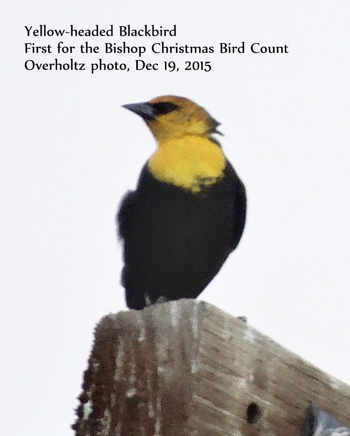 A good selection of rarities were found, notably a male Yellow-headed Blackbird which was new to the Bishop CBC. Yellow-headed Blackbirds typically vacate the Owens Valley for warmer climes in winter and return in late-March and early-April. This bird was photographed at a ranch south of Bishop. Also rare in December, three male Cinnamon Teal were observed during count week at Pleasant Valley Reservoir. Cinnamon Teal are typically absent from the Owens Valley mid-winter but return late-January as one of our first ‘spring’ migrants. A Least Sandpiper was found on count day, also at Pleasant Valley Reservoir. One team was lucky enough to find a Burrowing Owl beside an earthen burrow north of Bishop. Two teams photographed Yellow-bellied Sapsuckers, an immature bird in West Bishop and an adult male at the Golf Course. A silent Pacific Wren (a recent split from Winter Wren) was found in west Bishop. Two teams found single Lark Sparrows. A rare “Pink-sided” race Dark-eyed Junco was well-documented at the East Line Street Cemetery.
A good selection of rarities were found, notably a male Yellow-headed Blackbird which was new to the Bishop CBC. Yellow-headed Blackbirds typically vacate the Owens Valley for warmer climes in winter and return in late-March and early-April. This bird was photographed at a ranch south of Bishop. Also rare in December, three male Cinnamon Teal were observed during count week at Pleasant Valley Reservoir. Cinnamon Teal are typically absent from the Owens Valley mid-winter but return late-January as one of our first ‘spring’ migrants. A Least Sandpiper was found on count day, also at Pleasant Valley Reservoir. One team was lucky enough to find a Burrowing Owl beside an earthen burrow north of Bishop. Two teams photographed Yellow-bellied Sapsuckers, an immature bird in West Bishop and an adult male at the Golf Course. A silent Pacific Wren (a recent split from Winter Wren) was found in west Bishop. Two teams found single Lark Sparrows. A rare “Pink-sided” race Dark-eyed Junco was well-documented at the East Line Street Cemetery.
Only a few new high counts were established this year (2015 count/previous high count): Canvasback (16/9), Ring-necked Duck (237/162), Anna's Hummingbird (16/11), Black Phoebe (52/48), Red-breasted Nuthatch (13/7), Cedar Waxwing (230/206), and Lincon's Sparrow (53/48).
TRENDS – Here’s how 2015 compares with the past thirty-three Bishop CBCs:
- In 2015, Black-billed Magpie numbers were the second-lowest in the history of the Bishop CBC with only 42 birds encountered. In the late 1990’s through 2005, tallies over 150 were common.
- Geese – 2015 was one of six Bishop CBCs when no geese were found, though one Snow Goose was seen flying over the golf course during count week this year.
- In the 1980’s, Rough-legged Hawk tallies were frequently above ten or even up to twenty-one! In the past decade, we’re lucky to find one. In 2015, we missed entirely.
- Eurasian-Collared Doves were first encountered on the Bishop CBC in 2004 and are now ubiquitous.
- Between 1982 and 2002 no Anna's Hummingbirds were encountered on the Bishop CBC. Since then, numbers have increased nearly every year, reaching the maxima this year of sixteen Anna’s encountered by seven teams.
- Western Bluebird numbers have spiked in the past decade with 42 individuals tallied this year. Montain Bluebird numbers appear stable, though they were missed entirely this year.
Many thanks to all the talented and generous people who contribute to the Bishop CBC!
The 2016 Bishop CBC on Saturday, December 17, 2016 - SAVE THE DATE!
Chris Howard,
Bishop CBC Compiler
Back to Top
Report: Owens Lake Conservation Update from Pete Pumphrey and Michael Prather
Members of California’s Little Hoover Commission, Audubon California Board of Directors members and Audubon California staff, including Executive Director Bridgett McCormick toured Owens Lake on October 15 and 16. The trip was organized by Audubon California's Andrea Jones and escorted by Mike Prather and Pete Pumphrey from Eastern Sierra Audubon. The group came to Owens Lake to learn about the habitat protection strategies which have been developed through the Owens Lake planning process. They were looking for ways in which the Owens experience could suggest potential approaches to stakeholder participation and collaboration and habitat assessment and protection at the Salton Sea. The Salton Sea is overseen by the Little Hoover Commission and California Audubon has made the avian habitat at the sea a priority concern.
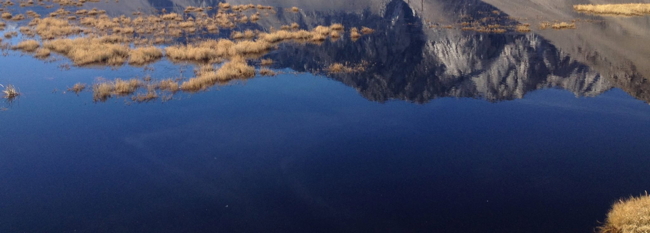
Cartago Springs Wildlife habitat at Owens Lake, Photo by Mike Prather
Accompanied by biologists from the Los Angeles Department of Water and Power, the group started out with an overview presentation at the Interagency Visitor Center, moved to the pump back station for an explanation of the mechanics of the lakes hydrology and the dust control project, and then drove along levee roads on the lakebed until reaching its final tour stop at the visitor access facility being constructed as a part of Phase 7a of the dust control project. ESAS representatives emphasized the importance of recruitment of a broad spectrum of stakeholders and persistence in the process. In addition, there was much discussion of the need to look at the wildlife habitat at Owens Lake as an integrated entity rather than as a series of disconnected small scale “projects.” This discussion focused on the development in the Owens Lake process of the Habitat Suitability Model and the use of that model for assuring the retention of habitat value as project implementation is begun.
Of course, with this group, there was also a lot of birding. Beginning with a vermillion flycatcher at the visitor center, sightings included peregrine falcon, golden eagle, northern harrier, white-fronted and snow geese and hundreds of ducks and shorebirds of various species.
ESAS is proud of its participation in shaping the future of the birds of Owens Lake and the habitat which sustains them. Hopefully, the lessons learned from more than seven years if work in the Master Plan/Master Project process will prove valuable at other critical spots such as the Salton Sea.
Back to Top
Save the Dates for these Owens Lake Events
Owens Lake 2016 Spring Big Day - Tuesday, April 19th
The 2016 Owens Lake Spring Big Day will be Tuesday, April 19th. We are looking for birders with at least some experience to help out in this intense bird census of Owens Lake. Contact Mike Prather to sign up. Small groups of citizen scientists will join with LADWP staff to spread across the lake and count EVERY BIRD WE FIND. Expect to see over 100,000 birds! Owens Lake is an Audubon Important Bird Area (IBA) with tremendous importance. It hosts tens of thousands of shorebirds and waterfowl and is the largest nesting location for Snowy Plovers in California. Our data collected on Big Days is used by LADWP, State Lands, California Department of Fish and Wildlife, Great Basin Unified Air Pollution Control District, and Audubon in the management and planning at Owens Lake.
To join in, or for more information, please contact Mike Prather at 760-876-5807 or mprather@lonepinetv.com. We will meet at 7AM at the Diaz Lake parking lot three miles south of Lone Pine on Highway 395.
Back to Top
2016 Owens Lake Bird Festival - Save the Date! April 22-24, 2016
We are already at work preparing for next year's festival! There will be many new additions as well as making the event two days instead of one. Again there will be a Friday evening meet-and-greet reception at the Lone Pine Film History Museum followed by two days of field trips and more on Saturday and Sunday. We have added "crack of dawn" trips, trips away from the lake, talks on migration and shorebirds, history of Owens Lake, photography trips, geology and more! So everyone mark your calendars. See you there.
If you are interested in getting involved and helping make the 2016 Festival even better, read this letter for potential trip leaders or presenters (also gives a "sneak preview" of what is planned so far!)
See the Friends of the Inyo Owens Lake Bird Festival page for more information.
Michael Prather
Back to Top
Taking Care of Business
Let Your Voice to be Heard!
We want to hear from you!! This short survey (it's only 6 questions, we promise) will provide the ESAS Board of Directors with helpful feedback on what you like most about the Eastern Sierra Audubon society!
Click on this link for the survey.
All answers are anonymous and will only be used to guide the board.
We appreciate your help and feedback!
Back to Top
Garage Sale - Loan us your Lawn for a good cause!
The ESAS board is looking for people to host this year's garage sale. If you have a home that can store donations for up to one week, has a great front lawn for display and can accommodate a crowd, we would love to hear from you.
Contact info@esaudubon.org if you are interested in hosting.
All proceeds from the garage sale go to supporting our ES Audubon high school scholarship fund.
Back to Top
Welcome New and Rejoining Members
Thank you to the members who recently joined or renewed their membership!
We'd like to take a moment to promote Chapter Memberships: You may not be aware of this, but 100% of Chapter Membership dollars stays locally in the Eastern Sierra, supporting local education, youth, conservation, and programs. If you don't need Audubon Magazine, consider joining or renewing as a Chapter-only member, or better yet, as both Chapter and National! We do get support from National Audubon, as well, so any membership helps, and is money well-spent toward bird and wildlife conservation and education, and we thank you!
Your membership donations help keep this chapter alive. We get 8-10 renewing members a month, and from 3-5 new members. Your membership dues make it possible for us to offer and support great educational and recreational events throughout the eastern Sierra. Thank you!
If you would like to join and help support Eastern Sierra Audubon, there are two ways you can do it:
- Join as a National Audubon Society Member, designating ESAS as your chapter affiliation. Includes Audubon Magazine subscription. This is $20 a year.
- Join as an ESAS Chapter-only Member for $20 per year. 100% of your donation stays here in the Eastern Sierra this way. Your chapter membership is a way to give back, and show your appreciation for all that ESAS does, and to help support our mission locally. Your membership helps pay for scholarships, programs, special events, education programs, research, and more. THANK YOU for your support!
Click Here for a membership form to join or renew!
Join National Audubon - your zip code will associate you with the chapter nearest you.
Back to Top
Thank You Maggie Riley!!
Our website guru has left the building!!
We want to take this opportunity to thank Maggie Riley for all of her dedication to the ESAS board, her communication efforts, website design and continual maintenance and for being a wonderful, joyful and delightful being to work with. Maggie faithfully kept our website running for the last 7 years and joined the board in 2010. She maintains that she loves to "mess around with web stuff" but recognizes that her job and her board position had her sitting at a computer for too many hours of the day!!
We will miss her enthusiasm and wonderful ideas and of course her ability to keep up with all of the information and make a beautiful, and user friendly website!!
ESAS asks that you bear with us as we make a transition in our website maintenance! We hope that we can provide as much information to you as Maggie has!!
Katie Larsen
Maggie says:
I'm not dead yet! :) Seriously, though, thank you so much for the kind words - they are most appreciated. I will be continuing to help with the transition as I am able, but I am truly excited to see where the "next generation" of ESAS leaders will take us! I am confident the website and newsletter is in very good hands with Katie Larsen taking it on.
Please continue to send articles and updates to newsletter@esaudubon.org to make sure they get in the monthly email newsletters and on the website.
We send out about one email each month to remind you of upcoming events - if you are not
on our email list, please
add yourself so you don’t miss anything!
All of our content is supplied by our awesome members... if you have any ideas about articles you’d like to see, or better yet, if you have anything to share for newsletter publication, whether an article, a news item, update, correction, poem, essay, artwork, photo, field trip report, neat birding experience, letter, etc, please send it, along with any comments or suggestions, to the newsletter
editor. We’d love to hear from you!
You may send items for inclusion in the newsletter at any time, but please
send any timely items to arrive before the first of the month, so they can
be included in the monthly email update.
Thanks for reading, and happy birding!
Katie Larsen and Maggie Riley, Transitional Newsletter and Web Team!
Back to Top
Calendar for January-February 2015 (and beyond!)
Back to Top















